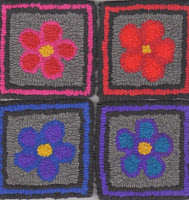I recently came across an interesting question, "How do I hook a white animal?", and I started thinking about how to hook (or paint) anything white…. white flowers, white animals, snow…
I think the best advice is from Claude Monet. He once gave some advice to another painter saying, "When you go out to paint, try to forget what objects you have before you — a tree, a house, a field. . . . Merely think, here is a little square of blue, here an oblong of pink, here a streak of yellow, and paint it just as it looks to you, the exact color and shape."
When we think of water - it's blue, trees are green, and polar bears are white. We need to forget what we know about objects and really look at their color and shape.
When we truly look at polar bears, snow, or white flowers we see many colors. In nature white reflects colors of the sky and even objects that are close.
I used natural, blue, and lavender wools in the snow in "December Snow". Some of the snow wools were spot dyed with blue and lavender.
Elizabeth Black wrote directions for hooking a white animal in her book
Hooked on the Wild Side. She suggests using undyed white wool as the highlight, undyed natural wool as the next value, and the third value is a tan or pale gray for the shadow. I do not have the expertise of Elizabeth Black, but I might also consider a very, very pale blue or violet for shadows. I suppose it depends on the colors of your rug and whether you want a warm shadow or a cool shadow. I have some blue wools that are so pale they almost look white - until I hold the two side-by-side and then the blue color is obvious.
In the article "Not Quite White" in Rug Hooking Magazine, Karen Larsen hooked two white snowy owls. She says that she used off white as her highlight. She had a gray windowpane plaid that was too dark, but she stewed that wool with her off white and the plaid released just a little color to dye the off white. She also used an herbal tea (lemon verbena, lemongrass, and peppermint) to dye more off white wool. She made the tea using 2 bags and added the colored water to her dye pan. She didn't allow the wool to stay in the pan more than 10 minutes and this produced a warm white. She began with off white and textured off white wools before her dyeing experiments.
Jane Halliwell Greene in
Rugs in Bloom, considers white flowers one of the most difficult to hook. She writes that only about 25% of the flower is white, the rest is color. She explains that where the sun shines on a flower is the highlight - where the white would be used. She suggests that this highlight might even be enhanced by hooking in a little yellow. Jane writes that a white flower is defined by its shadows and the background around it. She recommends pastel colors in the shadows - pale pinks, blues, and lavenders. She suggests that when you've finished hooking the flower, take a photo. Looking at the photo will help you to see if the colors are working to define the flower. I was thinking that if the photo can be downloaded to your computer and changed to a black and white photo, you could really see the values….
Hooked on the Wild Side, Elizabeth Black, p. 11
Nov/Dec 2012 Rug Hooking Magazine, "Not Quite White", Karen Larsen, p. 38-40.
Rugs in Bloom, Shading Flowers in Hooked Rugs, Jane Halliwell Green, p.14-16.


















































